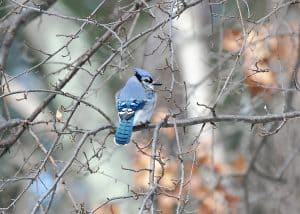
Who’s top bird at your feeder? An interesting thing to observe while you are identifying birds is who is displacing whom at the bird feeder. This displacement behavior in birds is called a “dominance hierarchy”. For instance, we think of doves as peaceful and jays as aggressive. Cornell Lab of Ornithology set out to study displacement behavior at feeders, to see who comes out on top in bird interactions. Project Feeder Watch participants have been gathering the displacement data.
Eliot Miller at Cornell Lab correlated 7,685 observations sent in by Feeder Watchers. In general, he found what one would expect, bigger is better. Blue Jays displace mourning doves and downy woodpeckers displace tufted titmice. But there were also some surprises.
The Project Feeder Watch Blog of October 9, 2017 reports on Miller’s study of 136 species of birds observed interacting at Feeder Watch sites in North America. Miller ranked each species based on how often it displaced other species, and how often it got displaced. Then he arranged all those species in their order of dominance. The highest- ranking species, the toughest bird, was the Wild Turkey. At the bottom of the list was the Eurasian Tree Sparrow. Eurasian Tree Sparrows, an introduced species which lives in parts of the mid-west, is closely related to our much more aggressive House Sparrows.
Miller found that although in most cases bigger birds are more aggressive than smaller ones, “it turns out that doves, buntings and grosbeaks are less dominant than we would expect based on their body size, whereas crows, jays, woodpeckers and blackbirds are more dominant than we would expect based on their size….doves really are peaceful and jays really are feisty.” But these patterns can be complicated and circular. “Some species appear to co-exist in a rock-paper-scissors arrangement. European Starlings are dominant to Red-headed Woodpeckers, Red-headed Woodpeckers are dominant to Red-bellied Woodpeckers, and Red-bellied Woodpeckers are dominant to European Starlings….This rare non-linear hierarchy may help balance continental patterns of abundance. Each species competes with another for nest cavities, but no species is always the winner.”
This study is ongoing at the Cornell Lab of Ornithology and Project Feeder Watch is in need of more feeder watchers to join the effort to document displacement behavior. Go to feederwatch.org to read the blog and Miller articles including his fascinating graphs of displacement, predation and mobbing behaviors. Join Project Feeder Watch in order to add your observations to this interesting citizen science effort.
Many thanks to all flora and fauna reporters for the month of March. Please send reports by April 26 for inclusion in next month’s article. You can call me at 692-3907, write me at 7A Old Colony Drive, or e-mail me at mariancharman@verizon.net.
Late February Reports:
Tom Ennis, Almeria Drive. February 25, first heard the woodcocks, “nearly to the day as last year, and slightly ahead of other years I have reported: 2015 no record, 2014, March 25, 2013, March 5, 2012, March 2.”
Marian/Bill Harman, 7A Old Colony Drive. February 28, two juncos, first chipmunk seen, red-tailed hawk soaring over the meadow.
Doug Pederson, at Beaver Brook Rd. February 27, saw several red-winged blackbirds yesterday at Forge Pond.
Rosemarie Koester, Providence Rd. February Report: tufted titmouse, chickadees, nuthatch, two pairs of cardinals, four blue jays, house finches, goldfinches, white-throated sparrow, chipping sparrow, juncos, heard a Carolina wren, heard an owl. February 20, immature male red-winged blackbird, more a few days later. Red-tailed hawk on Tadmuck Rd. Large hawk flew through the back yard. Heard a pack of coyotes late at night, several squirrels chasing each other. “One squirrel spotted with a big batch of leaves in its mouth. It proceeded to climb up a tree where it appeared to have a nest forming, and added these leaves. Chipmunks have come out. “Had a pair in the garage this morning, making a racket.”
Debbie Prato, Hayrick Lane. February 28, twenty turkeys and male house finch.
March Reports
Debbie Prato, Hayrick Lane March 2, Canada geese. March 3, had a hermit thrush the other day. “I was so happy”. March 9, robin, red-tailed hawk, lots of starlings. March 15, male and female bluebird eating suet today and a big, fat robin. “I gave him some raisins.” March 16, seven deer. March 23, skunk and raccoon. March 25, grackles, pair of house finches, cowbirds.
Doug Pederson, Woodland Drive. March 4, saw a goldfinch and house finch. March 19, Forge Pond, thirty hooded mergansers [Doug sent great photos-MH]. At Woodland Dr.,March 24, house finches and goldfinches at my feeder today. Also saw a flock of red-winged blackbirds.
Denali Delmar, Dunstable Rd. March 4, a pair of bluebirds at the suet–“How exciting!”
Marian/Bill Harman, 7A Old Colony Drive. March 7, snow on the ground, windy, 37 degrees. At feeder, downy woodpecker, red-bellied woodpecker, eight juncos, pair of cardinals. American crow on deck for stale chips–a first for us. Also, goldfinches, two titmice, a chickadee. March 8, 34 degrees, clear. Big snowstorm last night 8-10 inches, very heavy. Power is out and will be for several days they say. A new bird is at the suet, a male hairy woodpecker. Also, downy woodpecker, red-bellied woodpecker, three juncos, one chickadee, one titmouse, one white-breasted nuthatch, one blue jay, three goldfinches, one cardinal. March 9, 32 degrees, clear, no power. A lovely male cardinal in the pine tree, set against a snowy backdrop. March 10, clear, 35 degrees. Put out a new shelled sunflower feeder. Nine goldfinches flocked to it immediately, abandoning the thistle seed. A new bird showed up on the deck, a song sparrow. Power came on late today–Yay. March 13, 30 degrees, snowing, windy another foot of snow–third nor’easter this month. Mourning dove, ten goldfinches, twenty juncos, two white-breasted nuthatches, two chickadees, two cardinals, crows heard, two titmice, one house finch. Power stayed on! March 18, new bird on the deck, an American tree sparrow-very cute. Also juncos, goldfinches, two chickadees. March 23, eleven juncos, three goldfinches, one white-breasted nuthatch, two chickadees, two red-bellied woodpeckers, a pair of downy woodpeckers, American tree sparrow, heard crow and red-winged blackbird. In the afternoon, took a walk on the trail to the swamp. Saw four ducks flying overhead, quacking, probably mallards, lots of red-winged blackbirds on territory, crows heard, what looked like a fresh hairy woodpecker hole in a living pine, lots of deer prints. March 24, a cooper’s hawk watching our feeders from a nearby pine. All feeder birds vanished, and he gave up. March 25, 34 degrees, snow showers. A pair of red-belled woodpeckers came into the suet, male cardinal, six juncos, one white-breasted nuthatch, five goldfinches, one titmouse, two doves (at last our lonely dove brought a friend).
Debbie Gustafson, Mark Vincent Drive. March 11, a very light bird, hanging around with the juncos. [Debbie sent a photo, which I sent on to Dave Larson of Mass Audubon. He identified the bird as a leucistic junco–pretty unusual-MH]
Flavio Fernandes, Vineyard Rd. March 15, saw some robins at Miller school today.
Molly Miller-White, Forge Village. March 16, about ten bluebirds seen
Rosemarie Koester, Providence Rd. March report, several doves, one partially white. Two pairs of blue jays, red-winged blackbirds male and female, tufted titmouse, nuthatches, chickadees, nuthatches, goldfinches (one bright yellow), red-bellied and downy woodpeckers, field sparrow, white-throated sparrow, chipping sparrow, juncos lots, grackles, crow, two great horned owls calling to each other late at night, two hawks, one watching bird feeder, two deer in backyard, one smaller than the other, squirrels chasing each other, chipmunks who like to hide in our garage.
